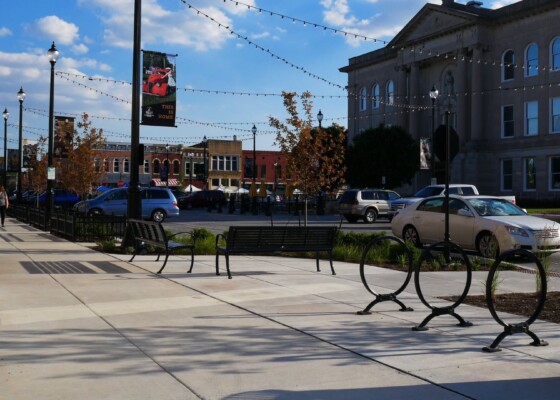Five Things We Learned From Scott Russell Sanders & Terry Tempest Williams
May 10, 2016Kindred spirits Scott Russell Sanders and Terry Tempest Williams joined Indiana Humanities for an INconversation on May 4 at the Eiteljorg Museum of American Indians and Western Art. View event photos…
Kindred spirits Scott Russell Sanders and Terry Tempest Williams joined Indiana Humanities for an INconversation on May 4 at the Eiteljorg Museum of American Indians and Western Art. View event photos here. Williams, a Guggenheim Fellow and titan of environmental literature, has been called a “citizen writer” for her fierce advocacy of freedom of speech about environmental issues. Sanders’ writing about the hills and forests of southern Indiana continues the tradition of essential Hoosier nature writers like Gene Stratton-Porter and Edwin Way Teale. Great friends with loads of mutual admiration, they chatted about the land and how we connect with it, how we should care for it, and how they work to champion it. For those of you who missed the conversation – or those who were there but simply would enjoy replaying some highlights – here are five things we learned:
- Our land is resilient … but we can’t take that for granted. “When you let nature go in the Midwest, it’s exuberant,” Sanders said. “If you plow a field and then leave it alone for five years, you’ll have a young forest.” However, he also noted that the land has its limits. We have lost massive amounts of Indiana’s original topsoil to erosion, and a majority of our surface water is so polluted that we should not fish or swim in it.
- We form our greatest connections to the land when we’re young. A child tends to imprint on the landscape they experience between the ages of five and 12, Sanders said. Both Sanders and Williams reflect this truism. He spent most of his formative years on a farm next to a military property that had been allowed to grow wild – a property where he could see bald eagles, foxes, beavers and more. As for Williams, one of her earliest and most formative memories came from when she was two years old and witnessed a great flash in the sky as her family drove through the night from California to Las Vegas (it was an atomic bomb test in the Nevada desert), but her connection with the landscape came from growing up near the Great Salt Lake. She said that great body of undrinkable water in the desert taught her that “Nothing is as it appears.”
- Great writers can help you see what you’ve never seen before. Words have the power to transport readers to another place, but also to make them feel compassion and a connection with somewhere they’ve never been before. “As a writer, I would hope that when you cut my words open they would bleed,” Williams said. And to Sanders, she said: “I think it was your writing that brought me back home – in a very real place.”
- Williams owns oil leases in Utah. She and her husband, Brooke Williams, bought the leases at auction to protect land from drilling. To respond to questions about whether she was going to extract fuel from the ground, Tempest wrote in the New York Times, “The energy we hope to produce through Tempest Exploration is not the kind that will destroy our planet, but the kind that will fuel moral imagination.” She and her husband could face criminal charges if they are found to have “misrepresented” themselves as “legitimate” energy-rights bidders. If they have not drilled on the land within 10 years, they lose their lease rights.
- Progress, used badly, can make us dangerous. “A person with a stone ax and a bad idea can do some damage,” Sanders said. “A person with a bad idea and a bulldozer can do a lot more damage.”
If you’re interested in more conversations like this one, join us on the trail for a Next Indiana Campfire. We’ll have 18 outings across the state – the first on May 11 at Oliver’s Woods just outside of Indianapolis. After that we’ll head to places like an old growth forest at Evansville’s Wesselmen Woods, the Indiana Dunes, the Limberlost and other iconic landscapes. And, don’t forget to order your FREE Trek and Talk Toolkit with materials to help you create your own DIY Campfire experience.
—————————————————-
Next Indiana Campfires is a unique way to connect nature, literature and Indiana’s Bicentennial. The program is supported by the Efroymson Family Fund, the Nina Mason Pulliam Charitable Trust and Pulitzer Prizes Centennial Campfires. Indiana Humanities is supported in part by Lilly Endowment Inc. and the National Endowment of the Humanities.
This post is part of the weekly blog series devoted to the initiative. Check back every Tuesday to learn more about Indiana’s great environmental literature, find out interesting facts about Hoosier stewardship, get all the latest program details and more.

